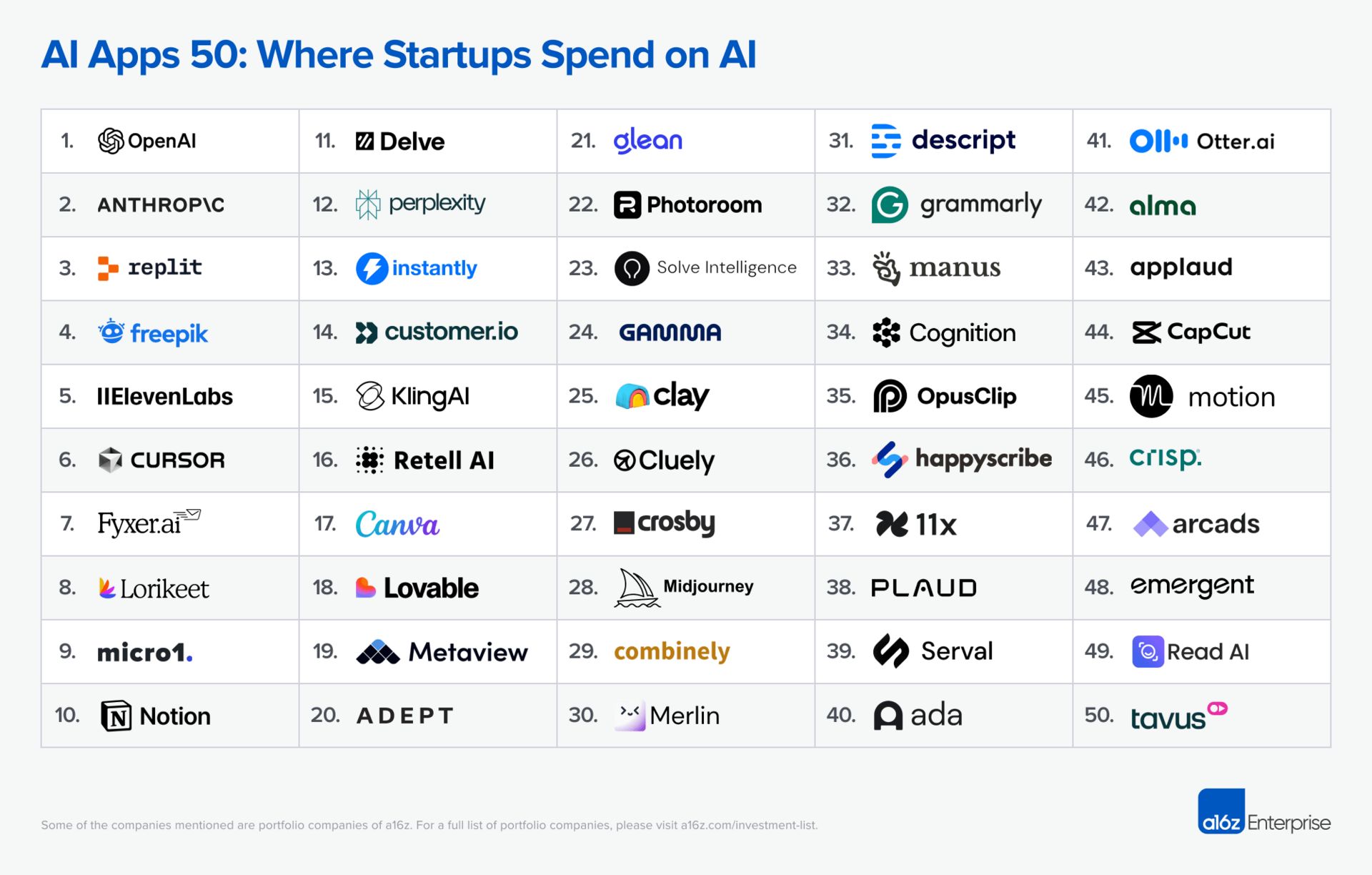- AutoGPT Newsletter
- Posts
- This is where startups actually spend their money with AI
This is where startups actually spend their money with AI

Hey, Joey here.
OpenAI has been SHIPPING, got to give them that,
And maybe we’ll talk about their new AgentKit soon… and no, it’s not an n8n killer.
But I wanted to focus on something more practical for your business this week in the deep dive.
Here is what’s in store:
📌 Resource: LLMs are dead - says Turing Award winner
📌 Resource: What are Chinese AI really worth
📌 Deep Dive: Where do startups ACTUALLY spend their money on AI
Let’s dive in 👇

DEEP DIVE
Startup AI Money Goes Here
Andreessen Horowitz’s lab dropped a report that caught my eye last week.
There’s no shortage of new AI tools out there. I probably scroll past 20 new ones a day.
But if you want to know what’s actually working, you follow the spend.
Their report highlights the 50 AI companies that startups are actually paying for.

I went through it and pulled out the tools that I think are most interesting.
Before we dive in, quick disclaimer:
I’m skipping the obvious ones: OpenAI, Midjourney, Anthropic, etc.
And yes — some of the inclusions in the list are kind of a stretch. Canva? Notion? Even Freepik? Just because they added an AI button doesn’t mean people are buying them for their AI.
Cool, now that that’s out of the way, here are the tools that stood out to me:
1. Fyxer.ai - AI email assistant
What it does: Fyxer helps manage email: drafting replies, organizing your inbox, summarizing threads, that kind of thing.
I’ve said before I don’t believe in the “all-in-one AI assistant” dream. It sounds good in theory, but ends up doing everything poorly.
What Fyxer does right is that it focuses on one thing (inbox management) and just makes it better.
Yes, you can build something like this yourself with ChatGPT and n8n… but you probably won’t. And it won’t be this clean.
It feels lightweight and fast. Exactly what you want in something that touches your email every day.
That said, if Google ever gets serious about AI in Gmail, this one might not be around for long.
2. Lorikeet, Retell, Ada - AI support chatbots
What it does: AI-powered customer support is one of the clearest use cases right now.
Especially for high-volume, low-touch tickets. Think “how do I reset my password” or “what’s your refund policy.”
These tools aren’t trying to replace entire support teams. They’re helping reduce the noise so your human agents can spend time on stuff that actually moves the needle.
Some companies overcorrected though and fired half their support team, then had to hire them back once they realized that yes, people still like talking to people.
Used well though, this category has real ROI.
3. Metaview, Cluely, Plaud, ReadAI - AI note takers
What it does: listens in your meetings and take notes.
This space is packed — Fireflies, Otter, etc.
But these ones made the a16z list, and they’re doing a few things differently.
Metaview is focused on recruiting calls.
Cluely tries to prep you before the meeting and help you answer questions on the fly.
Plaud and ReadAI seem to be leaning more into analytics and action items.
I’ve tested a bunch of these, the real value isn’t in the transcription. It’s in surfacing the useful parts later. And making you look more prepared, not just like you recorded a call.
There’s space for a few winners here, but we don’t need 20 of them. I’d guess this consolidates fast.
4. Motion - Create AI “employees”
This one’s in the same space as Artisan(with the controversial ad “Stop Hiring Humans”). or CrewAI: tools that let you spin up AI agents that do actual tasks in your business.
Motion caught my attention because it feels a bit more integrated than the others. It plugs into your calendar, CRM, and tools to help with ops.
Still early though. These are mostly GPT workflows wrapped in a nice UI.
But if you’re experimenting with agents to reduce grunt work, this is a good place to start.
Just don’t expect to replace hires with it just yet.
5. Arcads - Generate UGC ads with AI
This one is kind of wild.
You upload your product images, pick an AI actor, and it generates short-form video ads.
Feels borderline — basically fake testimonials in a shiny wrapper.
But used right, it’s a powerful tool for ad testing. Fast iterations, multiple hooks, different angles all without needing to hire UGC creators or book a studio shoot.
If you run paid traffic and care more about split-testing than polish, this might be a cheat code.
Just keep it ethical.

THAT‘S A WRAP
Before you go: Here’s how I can help
1) Sponsor Us — Reach 250,000+ AI enthusiasts, developers, and entrepreneurs monthly. Let’s collaborate →
2) The AI Content Machine Challenge — Join our 28-Day Generative AI Mastery Course. Master ChatGPT, Midjourney, and more with 5-minute daily challenges. Start creating 10x faster →
See you next week,
— Joey Mazars, Online Education & AI Expert 🥐
PS: Forward this to a friend who’s curious about AI. They’ll thank you (and so will I).
What'd you think of today's email? |

Reply